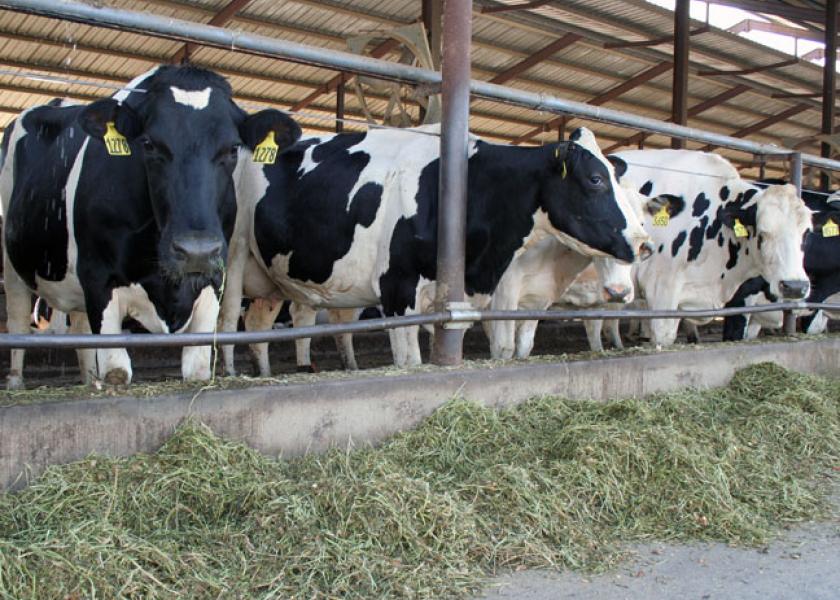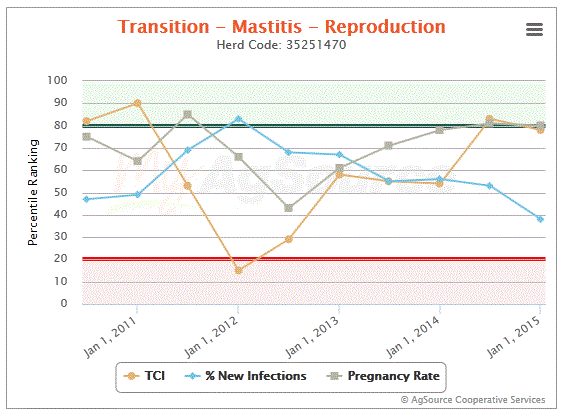On a Knife’s Edge

When cows are genetically wired to produce more than 150 lb. of milk per day within weeks of calving, any slight deviation in transition cow pens, bunk space or nutrition can short out best laid plans.
Just ask Kyle Levetzow. He, with his wife AmyBeth, milk 300 cows near Dodgeville, Wis., about an hour west of Madison. They thought they had their transition program figured out after fine-tuning facilities and rations for the past four or five years.
But over-crowding this winter, mostly a result of breeding success last year, and ration tweaks to a control dietary cation anion difference (DCAD) and straw diet brought them back to reality. “We had a slug of milk
fevers and displaced abomasums (DA),” Kyle says. DAs shot up to seven per month in January and February. They had just six in all of 2015.
Kyle’s dairy journey started in 2002, when he started milking on his own. He bought out and moved to his parents farm in 2006.
Prior to the move, he had been milking 60 cows in a tie stall barn. His parent’s facility had 170 mattress freestalls over a slotted floor and milked in a 16-stall rotary. To keep that facility at full bore, he calved all the cows and heifers at another facility.
That caused its own set of problems because the dry cows simply weren’t receiving the hourly attention they should. So in early 2011, he added 130 sand-bedded freestalls at the home place. And in the fall of 2011, in the second phase of the expansion, he added a 72' x 30' bedded pack pen for his pre-fresh group.
A 60' neck rail, rather than headlocks, is used at the bunk. That gives enough space for 25 to 27 head to eat at once, though it’s slightly less than the 30" of bunk space generally recommended for pre-fresh groups.
Then, in the spring of 2013, he redesigned his post-fresh pen adjacent to the parlor. Prior to the
remodel, he had 18 freestalls and not enough bunk space. The remodel pushed the post-fresh group to 25 stalls and 25 headlocks. He also splurged on high-end, $300 mattresses. Sand bedding was not an option since the fresh pen has slotted floors.
“We try not to run this pen to full capacity, and we try to keep it at 20 animals,” Kyle says. “We try to keep cows in the post-fresh pen for three weeks, and some will stay as long as 30 days if we feel they’re not quite ready to be moved. And if we get a calving slug, we will move out cows that are eating and milking well a day or two early.”
The chart at left shows Levetzow’s progress with the facility changes. “The report compares Kyle’s herd performance to all other AgSource herds of like size and lets Kyle know if he’s ‘keeping up with the Joneses,’ so to speak,” says Lisa Behnke, with AgSource.
From the chart, it’s clear the new pre-fresh and post-fresh pens made a difference. Kyle’s herd went from being well below average on Transition Cow Index and pregnancy rate to now being at the 80th percentile for both.
But, stuff happens. In 2013, Kyle switched from doing his own heat detection and AI to contracting with CRI for its “walk and chalk” program. He’s now achieving a nearly 40% pregnancy rate, with sexed semen no less, on his heifers. Pregnancy rate on the cows is 20% to 22%.
That rate of reproductive success led to a slug of freshenings this past winter, when Kyle and his nutritionist decided on a DCAD/straw-based diet in the pre-fresh group.
The combination of the ration change and over-crowding led to reduced dry matter intakes, Kyle says. That, in turn, led to the milk fevers and DAs.
“We’ve since changed the diet. We’re still trying to minimize potassium, but we’re no longer adding the salts,” he says. “That seems to have alleviated the problems.”
Levetzow’s post-fresh protocol relies on close cow observation. Any cow in the fresh pen down on milk in the morning will be added to a watch list. She’s checked for lethargy and discharges, and temped if necessary.
These suspect cows are closely watched for milk fever and DAs. Levetzow has also started using a blood ketone test to monitor for ketosis.
Kyle credits much of his fresh cow success to vigilant employees, particularly his assistant herdsman, Wilfredo Gutierrez.
“Wilfredo started here six years ago as a milker, and has grown into his role,” he says.
“A lot of herd management is getting the right people in place, and once you have them, it’s better to promote from within,” he continues.
The tank average is now 98 lb. per cow per day. That’s up from 90 lb. this past year and 86 lb. in 2013. Total solids sold per cow per day are now more than 6 lb.








